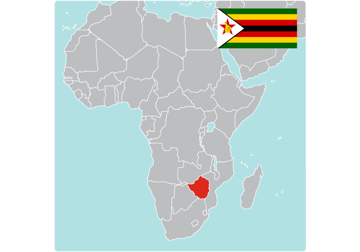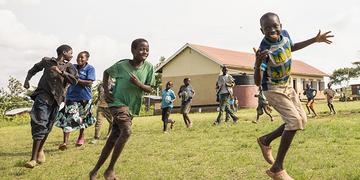EMERGENCY ALERT
Across Zimbabwe, at least 7.7 million people are struggling with food insecurity, including over 3.8 million children.
Before COVID-19, children were already being forced out of school to work and at risk of child marriage. Now, the pandemic has pushed more families to the brink. Our teams on the ground are deliverling lifesaving aid, helping reduce the risk of disease outbreaks, and more. But we can't do it without you.
Help Children in Zimbabwe
Zimbabwe, officially the Republic of Zimbabwe, formerly Rhodesia, is a landlocked country located in Southern Africa. Once known as the bread basket of the region, Zimbabwe was initially one of the most successful democracies in Africa.
But in 2000, the country began a rapid decline toward economic and social meltdown. Then came one crisis after another, including a cholera outbreak and climate change-related extreme weather events causing devastation, drought and massive food shortages that continue to this day.
Across Zimbabwe, millions of children are hungry and require urgent food assistance – or else lives will be lost.
Challenges for Children in Zimbabwe
Often lacking clean water, and surviving on what little food aid they receive, Zimbabwe’s children are desperate for your help. With the intensifying crisis, we’re also seeing unattended births and children missing vaccinations, children removed from school to work and girls driven into early marriage and motherhood.
1 child in 22 dies before their 5th birthday, 7 times the U.S. rate
24% of children suffer from stunting due to malnutrition
28% of children are engaged in child labor, instead of learning
21% of girls (ages 15-19) are married, and 1 in 12 gives birth
72% of people live in poverty

Our Results for Children in Zimbabwe
Thanks to giving people like you, our work for children in Zimbabwe is helping them not only survive but thrive, including the over 246,000 children whose lives we changed last year.
Thanks to you, we’re helping the most vulnerable families – like that of Ntokozo and his sons Joseph, age 7, and Sipho, age 13 – with emergency cash transfers, so they can feed and support their children.
54,000 children healthy and nourished
82,000 children educated and empowered
78,000 children protected from harm
31,000 children lifted from poverty
83,000 children aided in crisis
Our Work for Children in Zimbabwe
The world’s leading charity for children, Save the Children has worked in Zimbabwe since 1983. We serve children and families through lifesaving humanitarian relief and long-term development – not only saving lives, but implementing sustainable solutions to complex challenges.
Through our programs and advocacy efforts, together with government ministries and other partners, we help Zimbabwe’s children realize their rights and access quality health and nutrition, education and protection services. In times of crisis, Save the Children is there, responding to children’s unique and urgent needs.
We’re currently scaling up our emergency response to help the most vulnerable children, focusing on food security, health, nutrition, education and child protection. Our Emergency Health Unit has deployed to assess the crisis and set up emergency services. And we’re supporting vulnerable families through a cash transfer project, providing them with the funds they need to buy food and other essentials.
We’re doing do whatever it takes to ensure children in Zimbabwe grow up healthy, educated and safe, so they can build a better future for themselves, their families and communities.
Here are some recent examples of our work:
A healthy start in life
- To save children dying from malnutrition, Save the Children is conducting malnutrition screenings, counseling parents and providing lifesaving nutrition support to communities hardest hit by drought, with significant recovery rates
- With a focus on maternal, newborn and child health and nutrition, we’re strengthening the capacity of health facilities, implementing programs, promoting optimal feeding practices, conducing nutrition education and awareness campaigns, supporting community growth monitoring and more
Protection from harm
- We’re conducting family tracing and reunification programs, as well as protecting migrating children’s rights
- We successfully advocated for the adoption of legal frameworks that better protect unaccompanied migrant children
- We’re helping Zimbabwe fulfill its commitment to end child marriage
- We’re ensuring children, as well as police and educators, understand the child abuse risks associated with social media and other online activities
Emergency response
- We’re providing immediate humanitarian relief and recovery programs, as well as helping vulnerable communities prepare for future crises – this includes educating teachers and children about disaster risk reduction
- When Cyclone Idai wreaked havoc across Zimbabwe in 2019, we deployed our Emergency Health Unit for assessment and programming, reaching tens of thousands of people
- In response to the 2018 cholera outbreak, we implemented WASH – a highly effective clean water, sanitation and hygiene program — as well as health and child protection activities in affected areas
How to Help Children in Zimbabwe
Donate
Support Save the Children’s mission. Donate to help children in Zimbabwe and around the world grow up healthy, educated and safe.
Join Team Tomorrow
Join Team Tomorrow and your monthly donation will go toward addressing the needs of children affected by today’s most urgent issues.
Browse the Gift Guide
Give a meaningful gift that will help transform children’s lives and futures in Zimbabwe and beyond. There’s something for everyone!
Sources: Facts and statistics have been sourced from Save the Children’s monitoring and evaluation experts, as well as our thought leadership publications, including our Global Childhood Report 2020 report. Other sources include CIA World Factbook and BBC Country Profiles.
Photo: Sacha Myers / Save the Children.




